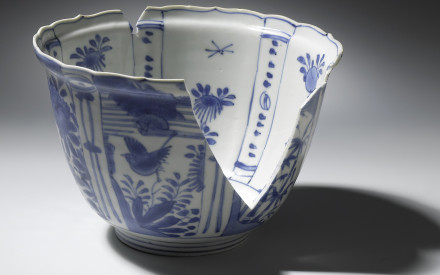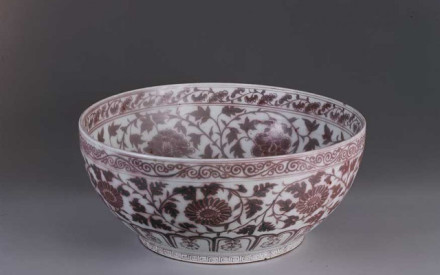In the seventeenth century, the trade routes of the Dutch East India Company (VOC) and English East India Company (EIC) brought millions of pieces of Chinese porcelain to Western Europe. This is a story well known to many. However, few people know that Chinese ceramics were a trade product long before this, and that they were already being sold in large quantities across the seas from the ninth century onwards.
An even more surprising insight is that ceramics provide the key evidence to a much wider historical narrative that took place for centuries on the trade routes of the Maritime Silk Road.1 Besides riches, this trade also brought many dangers. Treacherous reefs, violent storms and piracy made the voyages difficult. Countless ships sank on the way and never reached their final destination (fig. 1). The wrecks lay at the bottom of the sea for centuries. Large parts of the ships decayed and washed away, as did the cargoes of tea, spices and textiles. But the ceramics remained (fig. 2).
- 1The VOC was founded in 1602; previously the Netherlands operated under the ‘Voorcompagnieën’ (Pre-companies). The EIC was established in 1600.


Since the 1970s, dozens of these sunken ships have been excavated by archaeologists or salvaged by treasure hunters (fig. 3-4). While the main aim of the latter group of divers is the booty that can be sold, in the hands of a professional maritime archaeologist the context of the shipwreck can provide a wealth of unique information. This context is just as important as the treasures themselves, and it is therefore of the greatest importance that this information is registered correctly. The professionalisation of underwater archaeology has resulted in huge progress in the preservation of this unique heritage and thus an improved picture of our maritime past. A shipwreck is like a time capsule: it provides a special look at a lost world. Because ceramics can withstand the test of time so well, they are an excellent medium for telling these unknown stories.


Ships navigated the Maritime Silk Road for centuries, transporting trading products.2 But the route was also extremely important for the dissemination of ideas, religions and cultural traditions, and for the migration of people. The earliest stories about sea voyages in this region include those of Buddhist monks like the Chinese Fa Xian (fourth century) and Yijing (seventh century) who made voyages on ships. They were searching for the original writings of Buddhism in order to study them and propagate them further. Their journeys were often funded by pious merchants who thus also performed a good deed. Monsoons, the periodic winds in Asia, were of vital importance to the shipping routes; they determined when ships could leave. Put simply, there is a winter monsoon and there is a summer monsoon. In the winter period from December to March the wind blows mainly from the mainland from the northeast. In the summer period from April to September the wind comes from the sea from the southwest. The decline of the overland routes boosted the use of the sea routes in the eighth century. The Arabs also discovered how to develop ships that were capable of sailing further distances. In this period there were already many foreigners, including Persians, Arabs and Malaysians, living in major Chinese seaports like Guangzhou (also known as Canton) and Yangzhou. Around this time, Chinese ceramics developed into an export product that was in great demand in Southeast Asia and the Middle East. The Arabian Tang shipwreck that sank at the start of the ninth century and was discovered in 1998 provides the first concrete evidence of this vigorous trade. The cargo consisted of more than 60,000 ceramic items, from simple bulk goods to luxury objects (fig. 5-6).
- 2The concept of the Maritime Silk Road is derived from and is a version of the network of overland trade routes between the Middle East, Central Asia and China known as the ‘Silk Road.’ The strong centres of power in the Middle East and China ensured that trade flourished along these routes between the second and eighth centuries AD. This power crumbled around the seventh century, however, making trade via the Silk Road increasingly difficult and dangerous.


Until about the twelfth century, ceramics and other commercial products were transported mainly by foreign vessels from the Chinese ports to elsewhere. Then Chinese shipbuilding underwent a huge development. The introduction of the compass helped improve maritime knowledge and charts became increasingly accurate. These changes led to the Chinese actively taking part in the shipping routes. In the following period (Yuan dynasty, 1279–1368), China was dominated by the Mongolians. They took advantage of the maritime developments and used the Chinese ships and crews intensively, not only for military purposes but also for trade in Asia, both to the east and to the west. Thus we know that a ship that sank in 1323, now known as the Sinan Shipwreck, was on its way via Korea to Japan with a gigantic cargo of celadon (ceramics with a green glaze) on board, intended for temples and wealthy Japanese (fig. 7-8). This situation changed from the late fourteenth century when the Ming dynasty (1368–1644) was established. The Chinese emperors restricted and eventually even prohibited foreign trade; only tributes were still permitted.3 An illegal network of Chinese merchants grew quite quickly, and they established themselves in great numbers in the major seaports in Asia. At the same time, other regions like Thailand and Vietnam jumped on this gap in the market. This is also reflected in the shipwrecks from this period, with a profusion of ceramics from these areas. It was only in the late fifteenth century that Chinese ceramics regained their dominant position as a commercial product.
- 3The voyages of Zheng He under the command of Emperor Yongle (reign 1403–1422) formed a temporary upturn in trade.



Around 1500, Portugal and Spain successfully managed to navigate a route to Asia via South Africa, thus opening the way to trade between Europe and Asia (fig. 9). Spices were the most important commercial product, while the trade in Chinese ceramics would play an increasingly large role. The Portuguese and Spanish made grateful use of the centuries-old maritime networks in Asia. The Spanish marked the Philippines as their base, with Manila as the most important seaport. They also discovered the route to Mexico from Asia. This constituted the start of the Manila Galleons that sailed between Manila and Acapulco (Mexico). From 1580, Portugal fell under the Spanish kingdom as part of the Iberian Union. As a result, the port of Lisbon could no longer be used for the import and transit of goods from Asia. For the Netherlands, at war with Spain at the time, and also for England, this served as even more incentive to discover the route to Asia for themselves. However, it was difficult to set up a network in this area. One effective way of intimidating the Spanish and Portuguese was to seize their ships. This killed two birds with one stone: ships on their return voyage carried valuable cargoes that the Dutch VOC and the English East India Company (EIC) could easily sell in their own countries. This did not always happen without conflict, as shown clearly by the events involving the San Diego (sunk in 1600) and the Witte Leeuw (sunk in 1613). At the same time, the ship cargoes provide a unique picture of the kinds of commodities that were being traded in this early period during which Europe was active in Asia (fig. 10-13).




In the seventeenth and eighteenth centuries the European powers were extremely active on the Maritime Silk Road. During this period China exported enormous quantities of porcelain within Asia. Chinese ships transported it to a wide range of destinations where it was sold at markets to the local inhabitants, but also to the Western countries. The Chinese junk now known as the Hatcher Wreck (sunk around 1644) was probably such a ship. Batavia, now Jakarta, was a large market for Chinese ceramics. The VOC purchased large quantities of it there to ship to the Netherlands. It became increasingly easy from the late seventeenth century to place direct orders for specific shapes and decorations on Chinese porcelain. The Chinese seaport Canton (now Guangzhou) was also opened to Europeans in this period (fig. 14). The main product purchased in China was tea, followed by silk and other types of textiles and of course porcelain. The latter also served as ballast for the return voyage. This is well illustrated by the VOC ship Geldermalsen (sunk in 1752) which was carrying an enormous amount of tea as well as porcelain (fig. 15-16). The porcelain had been packed in between the tea.




The Western merchants still only had limited access to China in the eighteenth century, and this created more and more frustration. All the same, the imperial system in China was becoming increasingly unstable at the start of the nineteenth century partially as a result of the huge level of corruption in the country. England decided to make use of this weakness and resorted to trafficking opium illegally in China. Although this addictive substance was forbidden strictly by the emperor, it proved very attractive to the Chinese elite. This increased the trade in opium; very lucrative for the English but disastrous for China, since more and more people became addicted to the substance. The deteriorating political and economic situation in China meant that massive numbers of Chinese people, especially those from the coastal provinces, abandoned the country in search of work and a better life elsewhere. Borneo and Indonesia, with large Chinese communities already, were major destinations. The dramatic story of the Tek Sing shows that this journey was not without risk. That ship was heading for Batavia with more than 1,600 migrants on board. The ship struck a reef and sank; almost all the people on board died. When the wreck was salvaged in the 1990s, more than 350,000 pieces of ceramics were retrieved (fig. 17). This shows that trade in Asia still flourished, despite the economic downswing in China at the start of the nineteenth century.
*This article is the introduction to the publication Sunken Treasures. This book accompanied the exhibition Sunken Treasures: Secrets of the Maritime Silk Road on display at the Princessehof National Museum of Ceramics from 2019-2020. For more information on the exhibition and book click here.
Literature
Eline van den Berg & Karin Gaillard (eds.), Sunken Treasures: Discoveries in shipwrecks from the Maritime Silk Road 800-1900, Zwolle & Leeuwarden (Waander & Princessehof), 2019
Alan Chong & Stephen A. Murphy (eds.), The Tang Shipwreck: Art and exchange in the 9th century, Singapore (Asian Civilisations Museum) 2017
Shirley Fish, The Manila-Acapulco Galleons: the Treasure Ships of the Pacific, Bloomington 2011
C.J.A. Jörg, The Geldermalsen. History and Porcelain, Groningen 1986
Discoveries from the Sinan Shipwreck: Special Exhibition on the 40th Anniversary of the Excavation, Seoul (Kungnip Chungang Pangmulgwan / National Museum of Korea) 2016
Nigel Pickford & Michael Hatcher, The Legacy of the Tek Sing – China’s Titanic, its Tragedy and its Treasure, Cambridge 2000


















